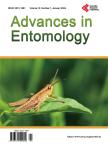Effect of Bendiocarb (Ficam<sup>®</sup>80% WP) on Entomological Indices of Malaria Transmission by Indoor Residual Spraying in Burkina Faso, West Africa
Effect of Bendiocarb (Ficam<sup>®</sup>80% WP) on Entomological Indices of Malaria Transmission by Indoor Residual Spraying in Burkina Faso, West Africa作者机构:Institut de Recherche en Sciences de la Santé Direction Regionale Bobo-Dioulasso Burkina Faso Université Polytechnique de Bobo-Dioulasso Bobo-Dioulasso Burkina Faso
出 版 物:《Advances in Entomology》 (昆虫学(英文))
年 卷 期:2020年第8卷第4期
页 面:158-178页
学科分类:1002[医学-临床医学] 100201[医学-内科学(含:心血管病、血液病、呼吸系病、消化系病、内分泌与代谢病、肾病、风湿病、传染病)] 10[医学]
主 题:Indoor Residual Spraying Bendiocarb Entomological Indices Malaria Vectors Burkina Faso
摘 要:Context: The vector control is essential in malaria prevention strategies in several endemic countries in Africa including Burkina Faso. The high transmission of malaria occurs during the period of high vector abundance (August to October) in Burkina Faso. Therefore, a vector control strategy based on the use of indoor residual spraying targeting this period should provide effective protection against malaria. This study aimed to evaluate the effect of bendiocarb applied in indoor residual spraying on entomological parameters of malaria transmission in a pyrethroid resistance area in southwestern, Burkina Faso.Methods: CDC light trap and early morning collections by pyrethrum spray catches were performed monthly to determine the change in entomological parameter within malaria vector in sprayed (Diebougou) and unsprayed sites (Dano). The female’s malaria vectors collected by both methods were used to determine their blood feeding pattern, biting and sporozoites rates as well as the malaria transmission risk estimated by entomological inoculation rate. Results: A total of 26,276 mosquitoes (13,555 anopheline and 12,721 other culicines) were collected using both CDC light trap (9158 mosquitoes) and PSC collection methods (17,118 mosquitoes) from June to December 2012. An. gambiae complex was the predominant species collected. An. gambiae was the predominant species collected (P = 0.0005), comprising 88% of the total collected and the most infected species. Malaria vectors densities were significantly lower in sprayed villages (n = 4303) compared with unsprayed villages (n = 12,569) during post-spraying period (P = 0.0012). In addition, mean human biting rate of An. gambiae s.l. and An. funestus s.l. were sign



